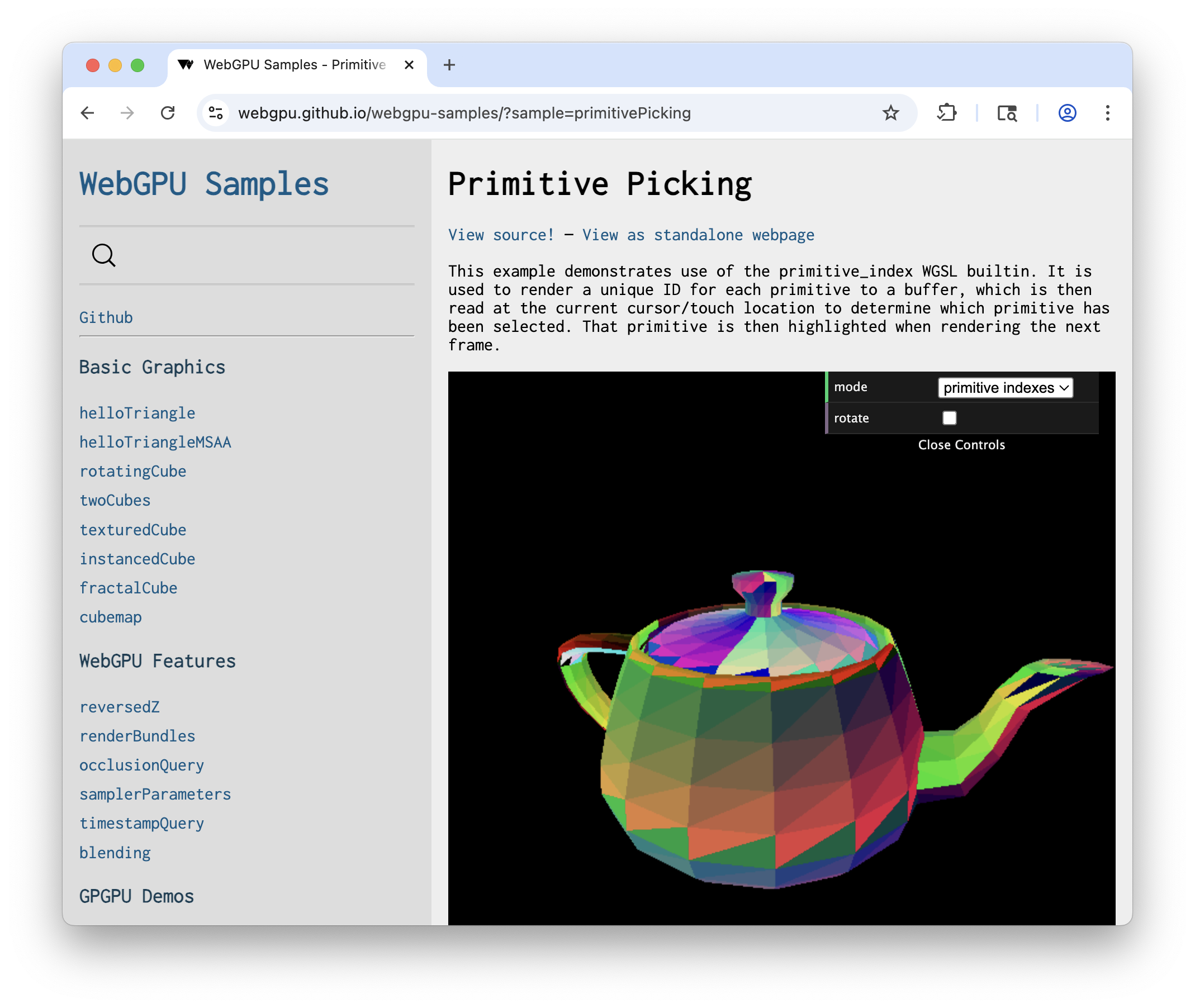Published: Oct 22, 2025
Texture format support capabilities extended
The new "texture-formats-tier1" GPU feature lets developers port existing content to the web without needing to rewrite it for WebGPU's lower capabilities. It supports new "r16unorm", "r16snorm", "rg16unorm", "rg16snorm", "rgba16unorm", and "rgba16snorm" texture formats with render attachment, blendable, multisampling capabilities and "read-only" or "write-only" storage texture access. It also allows existing "r8snorm", "rg8snorm", "rgba8snorm" texture formats with render attachment, blendable, multisampling and resolve capabilities. More texture formats can also be used with "read-only" or "write-only" storage texture access.
The new "texture-formats-tier2" GPU feature enables "read-write" storage texture access for specific formats, crucial for projects like porting Unreal Engine to the web. Note that enabling "texture-formats-tier2" at device creation automatically enables "texture-formats-tier1".
See the following snippet and chromestatus entry.
const adapter = await navigator.gpu.requestAdapter();
const requiredFeatures = [];
if (adapter.features.has("texture-format-tier1")) {
requiredFeatures.push("texture-format-tier1");
}
if (adapter.features.has("texture-format-tier2")) {
requiredFeatures.push("texture-format-tier2");
}
const device = await adapter.requestDevice({ requiredFeatures });
// Later on, when dealing with "r8unorm" texture formats for example...
if (device.features.has("texture-format-tier2")) {
// Use "read-write" storage texture access...
} else if (device.features.has("texture-format-tier1")) {
// Use "read-only" or "write-only" storage texture access...
} else {
// Fallback: Use another texture format...
}
Big thanks to the Intel folks for their work!
Primitive index in WGSL
The primitive_index is a built-in WGSL value that uniquely identifies the current primitive (for example, a point, line, or triangle) being processed by a fragment shader. It begins at 0, increments by 1 after every primitive is processed, and resets to 0 between each instance drawn.
When the "primitive-index" feature is available in a GPUAdapter, request a GPUDevice with this feature to get primitive index support in WGSL, and explicitly enable this extension in your WGSL code with enable primitive_index;. Once enabled, use the primitive_index built-in integer value in your fragment shader to access per-primitive data or perform logic that varies for each distinct geometric shape being rendered for example.
The following code snippet shows a fragment shader that renders the second primitive in red, and all other primitives in blue.
const adapter = await navigator.gpu.requestAdapter();
if (!adapter.features.has("primitive-index")) {
throw new Error("Primitive index support is not available");
}
// Explicitly request primitive index support.
const device = await adapter.requestDevice({
requiredFeatures: ["primitive-index"],
});
const fragmentShaderModule = device.createShaderModule({ code: `
enable primitive_index;
@fragment
fn main(@builtin(primitive_index) i : u32) -> @location(0) vec4f {
if (i == 1) {
return vec4f(1, 0, 0, 1);
}
return vec4f(0, 1, 0, 1);
}`,
});
// Send the appropriate commands to the GPU...
Explore more by checking out the Primitive Picking sample, and see the chromestatus entry.

Dawn updates
The DAWN_BUILD_MONOLITHIC_LIBRARY CMake variable used to handle the type of monolithic library to build has changed its default value from OFF to STATIC such that, by default the libwebgpu* files will be generated.
Dawn now handles properly wgpu::PresentMode::Undefined defaulting when configuring a wgpu::Surface. See issue 441410668.
This covers only some of the key highlights. Check out the exhaustive list of commits.
What's New in WebGPU
A list of everything that has been covered in the What's New in WebGPU series.
Chrome 143
Chrome 142
Chrome 141
- Tint IR completed
- Integer range analysis in WGSL compiler
- SPIR-V 1.4 update for Vulkan backend
- Dawn updates
Chrome 140
- Device requests consume adapter
- Shorthand for using texture where texture view is used
- WGSL textureSampleLevel supports 1D textures
- Deprecate bgra8unorm read-only storage texture usage
- Remove GPUAdapter isFallbackAdapter attribute
- Dawn updates
Chrome 139
- 3D texture support for BC and ASTC compressed formats
- New "core-features-and-limits" feature
- Origin trial for WebGPU compatibility mode
- Dawn updates
Chrome 138
- Shorthand for using buffer as a binding resource
- Size requirement changes for buffers mapped at creation
- Architecture report for recent GPUs
- Deprecate GPUAdapter isFallbackAdapter attribute
- Dawn updates
Chrome 137
- Use texture view for externalTexture binding
- Buffers copy without specifying offsets and size
- WGSL workgroupUniformLoad using pointer to atomic
- GPUAdapterInfo powerPreference attribute
- Remove GPURequestAdapterOptions compatibilityMode attribute
- Dawn updates
Chrome 136
- GPUAdapterInfo isFallbackAdapter attribute
- Shader compilation time improvements on D3D12
- Save and copy canvas images
- Lift compatibility mode restrictions
- Dawn updates
Chrome 135
- Allow creating pipeline layout with null bind group layout
- Allow viewports to extend past the render targets bounds
- Easier access to the experimental compatibility mode on Android
- Remove maxInterStageShaderComponents limit
- Dawn updates
Chrome 134
- Improve machine-learning workloads with subgroups
- Remove float filterable texture types support as blendable
- Dawn updates
Chrome 133
- Additional unorm8x4-bgra and 1-component vertex formats
- Allow unknown limits to be requested with undefined value
- WGSL alignment rules changes
- WGSL performance gains with discard
- Use VideoFrame displaySize for external textures
- Handle images with non-default orientations using copyExternalImageToTexture
- Improving developer experience
- Enable compatibility mode with featureLevel
- Experimental subgroup features cleanup
- Deprecate maxInterStageShaderComponents limit
- Dawn updates
Chrome 132
- Texture view usage
- 32-bit float textures blending
- GPUDevice adapterInfo attribute
- Configuring canvas context with invalid format throw JavaScript error
- Filtering sampler restrictions on textures
- Extended subgroups experimentation
- Improving developer experience
- Experimental support for 16-bit normalized texture formats
- Dawn updates
Chrome 131
- Clip distances in WGSL
- GPUCanvasContext getConfiguration()
- Point and line primitives must not have depth bias
- Inclusive scan built-in functions for subgroups
- Experimental support for multi-draw indirect
- Shader module compilation option strict math
- Remove GPUAdapter requestAdapterInfo()
- Dawn updates
Chrome 130
- Dual source blending
- Shader compilation time improvements on Metal
- Deprecation of GPUAdapter requestAdapterInfo()
- Dawn updates
Chrome 129
Chrome 128
- Experimenting with subgroups
- Deprecate setting depth bias for lines and points
- Hide uncaptured error DevTools warning if preventDefault
- WGSL interpolate sampling first and either
- Dawn updates
Chrome 127
- Experimental support for OpenGL ES on Android
- GPUAdapter info attribute
- WebAssembly interop improvements
- Improved command encoder errors
- Dawn updates
Chrome 126
- Increase maxTextureArrayLayers limit
- Buffer upload optimization for Vulkan backend
- Shader compilation time improvements
- Submitted command buffers must be unique
- Dawn updates
Chrome 125
Chrome 124
- Read-only and read-write storage textures
- Service workers and shared workers support
- New adapter information attributes
- Bug fixes
- Dawn updates
Chrome 123
- DP4a built-in functions support in WGSL
- Unrestricted pointer parameters in WGSL
- Syntax sugar for dereferencing composites in WGSL
- Separate read-only state for stencil and depth aspects
- Dawn updates
Chrome 122
- Expand reach with compatibility mode (feature in development)
- Increase maxVertexAttributes limit
- Dawn updates
Chrome 121
- Support WebGPU on Android
- Use DXC instead of FXC for shader compilation on Windows
- Timestamp queries in compute and render passes
- Default entry points to shader modules
- Support display-p3 as GPUExternalTexture color space
- Memory heaps info
- Dawn updates
Chrome 120
- Support for 16-bit floating-point values in WGSL
- Push the limits
- Changes to depth-stencil state
- Adapter information updates
- Timestamp queries quantization
- Spring-cleaning features
Chrome 119
- Filterable 32-bit float textures
- unorm10-10-10-2 vertex format
- rgb10a2uint texture format
- Dawn updates
Chrome 118
- HTMLImageElement and ImageData support in
copyExternalImageToTexture() - Experimental support for read-write and read-only storage texture
- Dawn updates
Chrome 117
- Unset vertex buffer
- Unset bind group
- Silence errors from async pipeline creation when device is lost
- SPIR-V shader module creation updates
- Improving developer experience
- Caching pipelines with automatically generated layout
- Dawn updates
Chrome 116
- WebCodecs integration
- Lost device returned by GPUAdapter
requestDevice() - Keep video playback smooth if
importExternalTexture()is called - Spec conformance
- Improving developer experience
- Dawn updates
Chrome 115
- Supported WGSL language extensions
- Experimental support for Direct3D 11
- Get discrete GPU by default on AC power
- Improving developer experience
- Dawn updates
Chrome 114
- Optimize JavaScript
- getCurrentTexture() on unconfigured canvas throws InvalidStateError
- WGSL updates
- Dawn updates

